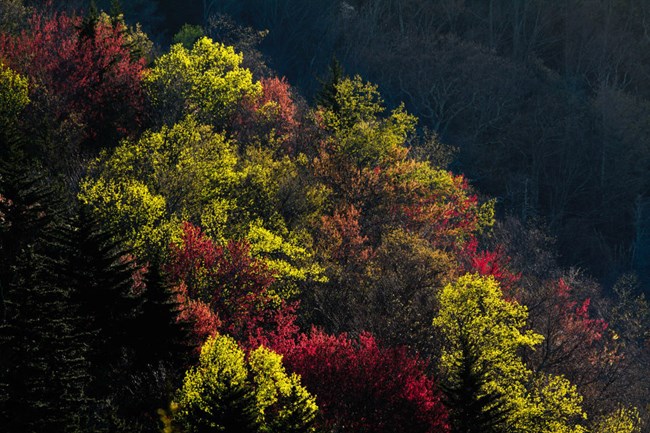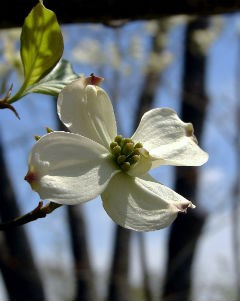
Danielle Austen photo Forest TypesMore than 2,000 species of plants live in the forests and meadows of the Blue Ridge Parkway. Nearly 85% of parkway lands—over 70,000 acres—are covered by forest. Five distinct forest types can been seen as you travel the 469-mile length of the parkway: Spruce-Fir ForestsThe tallest places are home to forests usually found in Canada or Maine. Above 4,500 feet, Fraser fir and red spruce are most common, but you will also find yellow birch, mountain-ash, hobblebush, and blackberries. To spot this forest from a distance, look for dark green evergreen trees near the summit.How to tell spruce from fir: The easiest way to identify spruce and fir trees is to look at their needles. Spruce trees have square-tubed needles that easily roll between your fingers. Fir trees have flat needles that are hard to twirl. Remember, “S” is for Spruce and Square and “F” is for Fir and Flat. 
Jim Ruff photo Northern Hardwood ForestsNorthern hardwood forests are found between 3,000 to 5,000 feet. American beech, yellow birch, and maple trees are the most common, although many other species also grow here. The trees here are deciduous, which means their leaves drop in the winter. In the fall, this forest produces the most brilliant fall color.Cove Hardwood ForestsBelow 4,500 feet, moist coves and hollows support large trees, such as sugar maple, basswood, and birch. Coves are sheltered valleys with deep, rich soil that support forty to sixty different species of trees and shrubs. Scientists often describe this forest as the most diverse in North America.
Trent Silker photo Oak-Pine ForestFive types of oak and as many pines populate the dry, rocky slopes at low elevations. Hillside blueberry, black huckleberry, and mountain laurel take advantage of sun filtering through gaps in the tall trees.BaldsBalds are places without trees at middle to high elevations. The parkway has two types of balds: grassy balds and heath balds. Both types have specific plant and animal communities. Early settlers in the Southern Appalachians sometimes referred to health balds as "laurel hells" because the shrubs growing on them were so thick and tangled that it was "hell" to try to walk through them.Although balds have existed for thousands of years, some are giving way to forests. The trees in these areas may look like young saplings, but are often 200 years old. |
Last updated: April 26, 2024
